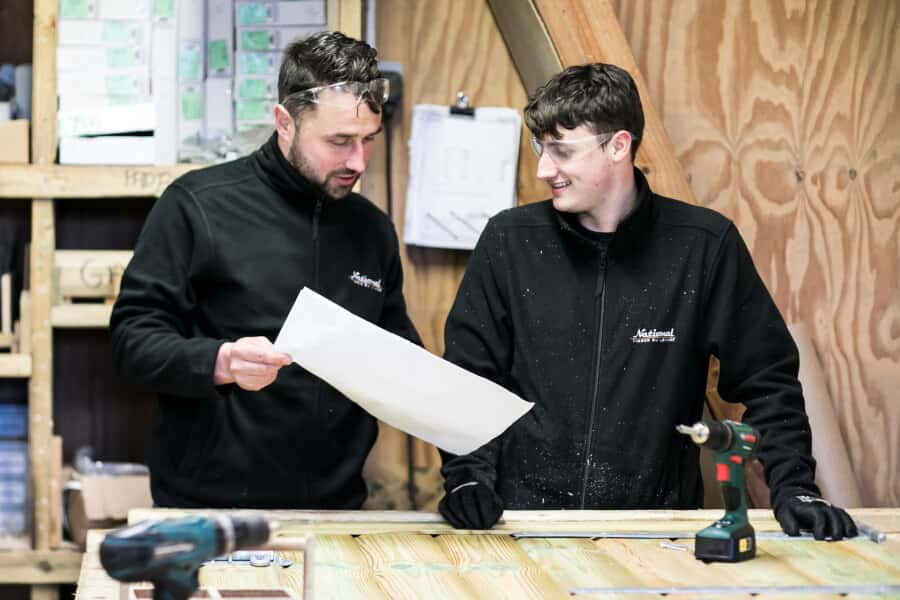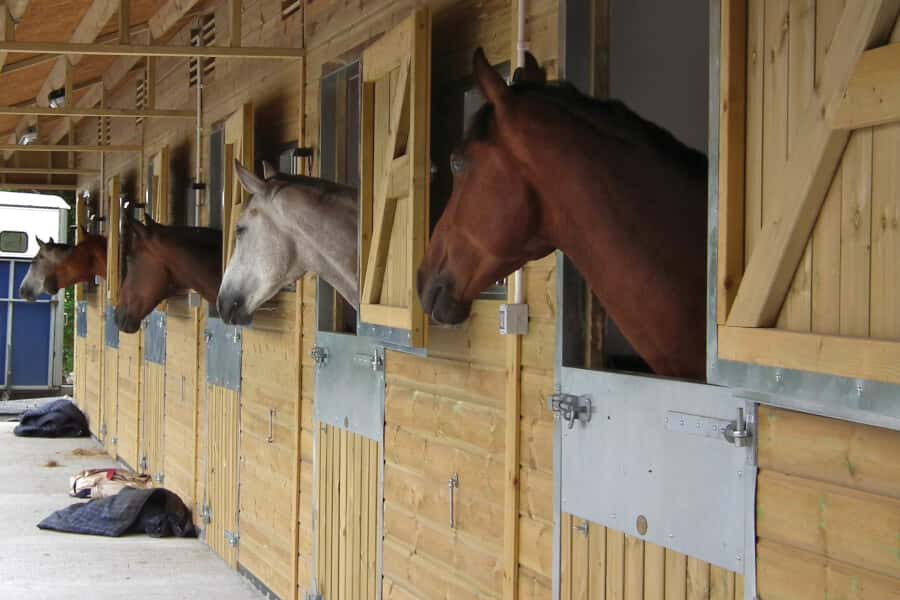The importance of a killer stable plan
Every horse owner will tell you that owning a horse is immensely rewarding. Caring for their needs daily and witnessing them grow and develop brings out a sense of selflessness in horse owners like parents care for their children. It also takes time, discipline, and skill – not everyone can manage a 1,000-pound animal, let alone ride, and train it.
When you cast all the love, commitment, and sense of achievement to one side, the reality is, owning a horse also takes a ton of hard work. Getting up at the crack of dawn to head down to the yard and hand out morning feeds, muck out last nights poop, change the water bucket (just for it to be kicked over again), as well as all maintaining all the grooming and exercising horses need, is no mean feat especially when you’re battling against windstorms, mud, ice, and horizontal rain in the middle of winter!
![]() A WELL-PLACED, EXPERTLY DESIGNED STABLE LAYOUT CAN MAKE ALL THE DIFFERENCE TO A HORSE OWNER.
A WELL-PLACED, EXPERTLY DESIGNED STABLE LAYOUT CAN MAKE ALL THE DIFFERENCE TO A HORSE OWNER.
Planning your perfect stable
The key things to consider when planning your perfect stable are:
Location
You may find that you have limited space and options when it comes to where to site your stable block. We advise our customers to focus on access, services (water and electricity) and the prevailing wind when trying to find the right location for their stable. With the UK’s prevailing wind coming from the South-West, the ideal position would be for the stable doors to face south to prevent rain, snow and wind blowing in, but the strong summer sun can make stables stifling, which is not ideal if you need to stable your horse during the day. On the other hand, north facing stables that see little sun in winter will get very cold, making practicalities like drying floors challenging (and uncomfortable) for horses.
If you have a choice about the siting of the stable, east-facing is a good compromise. The stables will enjoy the morning sun in winter and will avoid most of Britain’s strongest rain and winds travelling in from the west.
Once you have found a site for your stable that works both in terms of practicality and weather, you need to think about access and services. Try and imagine yourself in the depths of winter when you do this – mud, rain, and freezing temperatures will all make tasks such as steering wheelbarrows overloaded with muck even more difficult and depressing if your location is not well thought through. For example:
- Where will your muck heap be? Keep it close enough for ease of access from the stables, but far enough that flies and potential fire hazards do not become an issue.
- Is your stable located near a water/electricity supply? Factoring in access to electricity and water when budgeting for your project is crucial. The closer your stable is to existing water and electricity supplies, the cheaper and easier it will be. Running a new pipe and new cabling can bump up costs dramatically. It is worth getting a quote from your electricity and water companies first, as well as a quote from contractors, to ensure it is all connected properly. Remember, you will be filling buckets with water constantly for one thing or another, so you might want to consider having a water supply to each stable. Insulating pipes from the get-go will help avoid freezing pipes in winter.
- Does your location have easy access to grazing? Easy and quick access to fields at turn out time is particularly helpful in the winter when it gets dark earlier, as is a yard entrance/exit that leads directly into the field – it makes vehicular access easier when loading horses into horseboxes.
- Do you have sufficient drainage nearby? Whether you prefer drainage to be placed at the rear or front of the building, runoff water will need a gentle slope to run down towards the drain.
Good lighting will make it easier for you to check around the stable and care for your horse as well. If you can run electricity to the stable, you will want to include lights within each stable and plenty or external lighting around the yard too. Keep all wires and light switches far away from horses to avoid chewing and if you can include an external plug socket, all the better. Your farrier will thank you for it. If electricity is not an option within your stable, there are some great solar lighting options on the market that might provide a suitable alternative.
Stable Size
The British Horse Society (BHS) offer great advice on stable management to help you plan your new stable layout from a safety point of view. The BHS recommend the following minimum stable size recommendations:
- Horses: 3.65m x 3.65m (12ft x 12ft).
- Large horses: 3.65m x 4.25m (12ft x 14ft).
- Ponies: 3.05m x 3.05m (10ft x 10ft).
- Large ponies: 3.05m x 3.65m (10ft x 12ft).
- Foaling box: (horse): 4.25m x 4.25m (14ft x 14ft).
As a guide The Donkey Sanctuary minimum stable sizes for donkeys are:
- Mules: 3.65m x 3.65m (12ft x 12ft).
- Donkeys: 3.05m x 3.05m (10ft x 10ft).
- Large donkeys: 3.05m x 3.65m (10ft x 12ft).
We can customise our extensive range of wooden stables to your exact requirements. Whether you require a smaller build from our Novice range, bespoke field shelters, American barn stables, or our crème de la crème Cheltenham Gold range, we can design beautiful equestrian buildings that will last a lifetime. Obviously, the larger your stable, the more comfortable and (more likely) a lot cleaner it will be too. Your budget, acreage and planning permissions will determine your maximum size for you – we’ll get to planning shortly.
Stable Design & Layout
- L-shaped stables and straight-line stables are the most popular layouts chosen by our customers. However, we can design and build your stable block to whatever practical layout works best for you and your horse(s). L-shape layouts work well for smaller stables as you can position the stable to keep out the wind and is ideal if you want to include a tack room, feed area or hay barn within your design.
- U-shaped stables are great solutions for horse owners needing a larger number of stables. It allows you to maximise protection from the elements as well as create a layout where horses (and horse owners) can see and socialise with each other. A washing area, hay storage, tack rooms, feeding rooms are not a problem with this layout. We can even enclose your U-shaped stable block with a standout arched entrance. We can even include a stable office if budget allows.
- You can never have enough storage space when you own a horse! Really think about how you can make your time at the yard as efficient and enjoyable as possible. Consider where and how you will your store all the equipment and supplies that come with having a horse. It is a clever idea to inventory of what you are storing in your tack room, so you know what you are going to be storing there. How many horses and number of saddles per horse need to be housed? Will your tack room be storing only saddles and bridles, or will it be used to also store other equipment like wraps, blankets, rubber mats and other bits too?
You might even consider building in some benches or seating areas into the tack room (or yard). It will encourage riders to socialise together while in each other’s company. Would some extra cupboards for refreshments be a good idea too? Tiny details such as these can really make a significant difference to how well you enjoy and use your time with your horse and friends at the yard. You are going to be there a lot, so organise it precisely how you want it.
- Let there be light. The stable should be a naturally light space. Just like us, sufficient light will not only allow horses to see well, but it will also provide comfort and keep them in high spirits too. Windows are an important consideration – how many? Where to place them? Mesh covered? It’s up to you.
Adding in plenty of windows will ensure there is abundant ventilation in the stable year-round. You can also achieve this through the stable doors, adequate roof height, and air vents.

Planning Permission
Once you have had a good think about your design and layout, you need to check that what you want to build fits with the planning permissions of your local council. Each local authority is different, and permission will very much depend on the location of your proposed stable and whether it sits within the confines of the property or agricultural land it is sited on. We can help you with your planning application, but in the meantime check out our guide on the planning permission process for stables to get you started.
Our top planning application tip:
Be realistic and as flexible regarding the design and location of your proposed stable as you can. This can make all the difference as to whether your application is successful. Being honest and helpful with the local planning authority during the application will help the process run smoothly and swiftly.
Quality Materials
Last but not least, high-quality materials will be key to building a durable, long-lasting stable. Here at National Timber Buildings, we manufacture all timber structures in house, with Tanalised®, quality wood, so getting a high-end build and finish is something you do not have to worry about with us. We also spend a lot of time perfecting the stable door design with our customers as they are essential to a smooth operating stable. We will collaborate with you to design the ideal doors for your requirements. Whether it is doors with latches so that they can be undone easily or secure fastening to keep horses safe at night, we will find the perfect stable layout, design, and doors for you.
The Stable Design Process At National Timber Buildings
Over our 40 years in business, we have developed designs that are unrivalled in the world of stables and loved by all our clients. It also means that we have our stable and timber building design process down to a T!Our seven-step stable design process will help anyone struggling with deciding what they want from their new stable.
Yes, it’s true, looking after horses can be time consuming and expensive. However, nailing the perfect stable design and layout will help keep your time with horses (and human) friends enjoyable, stress-free, and efficient. Leaving you to enjoy more time with your pals, appreciate those beautiful rides, and make tons of memories together. Having your stables designed, manufactured, and built by professionals in the industry, to your exact requirements will not only ensure quality, but longevity and beautiful craftmanship too.

Your free brochure
We make sure every prospective client has a copy of our brochure – this gives you the chance to browse examples of our products and see the quality of our workmanship. Plus, you will find details of our pricing so you can begin planning your project properly. From a stable block to a mobile stable, you will find an option to suit you perfectly.
Our brochure is 100% free of charge and is the perfect way to get your project off the ground.
Enter your postcode to request your brochure.




